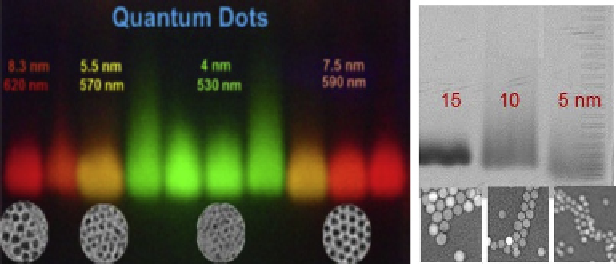Biomedical Engineering Reference
In-Depth Information
payloads, such as taxol plus other chemotherapeutic drugs which can solve the
issue of drug resistance in cancer cells. This can avoid the possibility of their
escaping treatment by attacking them with more than one kind of drug at a time.
5.9.6 Semiconductor NPs
One of the more significant advancement involves the use of semiconductor
NMs for the delivery of vaccine to prevent diseases that currently do not have any
cure or preventive drugs. In a proof-of-concept study, the use of <15 nm, water-
soluble, inorganic NPs as a vaccine delivery system for a blood-stage malaria
vaccine was recently reported.
196
The recombinant malarial antigen, merozoite
surface protein 1 (rMSP1) of
Plasmodium falciparum
was used as the model
vaccine.
197
Using published protocols, the rMSP1 was covalently conjugated to
water-soluble amphiphilic polymer-coated QD, CdSe/ZnS NPs, using surface
carboxyl groups to form rMSP1-QDs. In this study, the anti-MSP1 antibody
responses induced by rMSP1-QDs were found to have 2-3 log higher titers than
those obtained with rMSP1 that were administered with the conventional adju-
vants, Montanide ISA51 and CFA.
196
In addition, the immune response and the
induction of parasite inhibitory antibodies were significantly higher in mice that
were injected with rMSP1-QDs. The results were similar whether the rMSP1-
QDs were delivered via intraperitoneal, intramuscular, and s.c. routes. Very high
levels of immunogenicity from injections of the rMSP1-QDs were achieved
without further addition of other commercial adjuvant components. Dendritic
cells that were bone marrow derived showed efficient uptake of the QDs (
Figure
5.7
) which were suspected to cause their activation and the expression/secretion
of key cytokines, suggesting that this may be the mechanism for the enhanced
immunogenicity. This study provides promising use of water-soluble, inorganic
semiconductor NPs (<15 nm,
Figure 5.8
) as potent platforms to enhance the
immunogenicity of polypeptide antigens in adjuvant-free immunizations. This
FIGURE 5.8
TEM and gel electrophoresis of QDs (left) and IOMNPs (right) that are <15nm in
diameter.
(For color version of this figure, the reader is referred to the online version of this topic)


